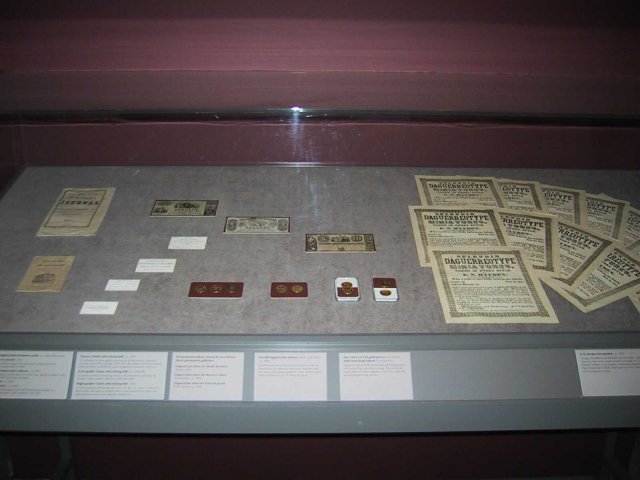

Click on any of the thumbnails below to view in a larger format
 Vintage broadsides and handbills are rare
today; originally, however, they were usually printed a thousand at a time.
Since Hayden worked as an itinerant, or traveling, daguerreotypist, these
broadsides include blank spaces for the changing location of his temporary
studio.
Vintage broadsides and handbills are rare
today; originally, however, they were usually printed a thousand at a time.
Since Hayden worked as an itinerant, or traveling, daguerreotypist, these
broadsides include blank spaces for the changing location of his temporary
studio.
 To advertise his new gallery location at 349
Broadway, Jeremiah Gurney issued this amusing “$349 bill.” His earlier $100
promotional note had been confused by some as genuine banknote currency.
To advertise his new gallery location at 349
Broadway, Jeremiah Gurney issued this amusing “$349 bill.” His earlier $100
promotional note had been confused by some as genuine banknote currency.
 A crudely printed advertising bill in a
denomination matching the studio’s street address between 1846 and 1848.
A crudely printed advertising bill in a
denomination matching the studio’s street address between 1846 and 1848.
 A finely printed advertising note by E. B.
& L. G. Chase, of Boston. Reportedly, this was so realistic that it was
passed by at least one unscrupulous person as a genuine banknote.
A finely printed advertising note by E. B.
& L. G. Chase, of Boston. Reportedly, this was so realistic that it was
passed by at least one unscrupulous person as a genuine banknote.
 Scovill made brass daguerreian tokens—both for
themselves first (to advertise their own supplies,) and then for some of the
larger galleries—that at first glance looked identical to a US $10 gold
piece.
Scovill made brass daguerreian tokens—both for
themselves first (to advertise their own supplies,) and then for some of the
larger galleries—that at first glance looked identical to a US $10 gold
piece.
 Left) Daguerreian token, with 1850 date stamped
on obverse, struck for John H. Fitzgibbon of St. Louis.
Left) Daguerreian token, with 1850 date stamped
on obverse, struck for John H. Fitzgibbon of St. Louis.
Center) Daguerreian token, ca. 1853 struck for the Philadelphia studio of Marcus A. Root.
Right) Daguerreian token, ca. 1850 struck for Edward Jacobs, New Orleans.
 This deliberate attempt to use advertising
tokens that imitated genuine coinage rarely failed to draw a glance, and thus
forcefully conveyed the advertising message.
This deliberate attempt to use advertising
tokens that imitated genuine coinage rarely failed to draw a glance, and thus
forcefully conveyed the advertising message.

14) Hawes & Somerby, 1842
Josiah J. Hawes began his celebrated partnership with Albert S. Southworth in 1843.
15) Brady’s Daguerreian Galleries, ca. 1853
Brady opened his second New York City Gallery in March 1853; this card advertises both locations.
16) James Ford, ca. 1854
17) Samuel Masury, ca. 1858
It is notable that Masury was still advertising himself as a daguerreotype artist at this relatively late date.
 The first U.S. photography journal, edited by
S. D. Humphrey, of New York; a trade publication intended for professionals. The
first issue appeared in November 1850.
The first U.S. photography journal, edited by
S. D. Humphrey, of New York; a trade publication intended for professionals. The
first issue appeared in November 1850.
 Written by Ned Buntline, this novelette centers
on the crucial role of a daguerreotype in a boy-meets-girl tale. A promotional
pamphlet, given away free as advertising.
Written by Ned Buntline, this novelette centers
on the crucial role of a daguerreotype in a boy-meets-girl tale. A promotional
pamphlet, given away free as advertising.
 CHASE BROADSIDE |
 ELY BROADSIDE |
 FORD BROADSIDE |
 LEWIS BROADSIDE |
 YOUNG BROADSIDE |
 BUTTON BROADSIDE |
 SISSON INVOICE |
 GENERAL MARION |
 MAJOR ANDRÉ |